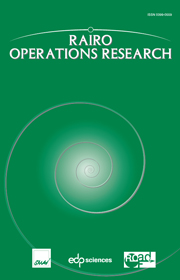No CrossRef data available.
Article contents
Polyhedral Reformulation of a Scheduling Problem And Related Theoretical Results
Published online by Cambridge University Press: 20 August 2008
Abstract
We deal here with a scheduling problem GPPCSP (Generalized Parallelism and Preemption Constrained Scheduling Problem) which is an extension of both the well-known Resource Constrained Scheduling Problem and the Scheduling Problem with Disjunctive Constraints. We first propose a reformulation of GPPCSP: according to it, solving GPPCSP means finding a vertex of the Feasible Vertex Subset of an Antichain Polyhedron. Next, we state several theoretical results related to this reformulation process and to structural properties of this specific Feasible Vertex Subset (connectivity, ...). We end by focusing on the preemptive case of GPPCSP and by identifying specific instances of GPPCSP which are such that any vertex of the related Antichain Polyhedron may be projected on its related Feasible Vertex Subset without any deterioration of the makespan. For such an instance, the GPPCSP problem may be solved in a simple way through linear programming.
Keywords
Information
- Type
- Research Article
- Information
- Copyright
- © EDP Sciences, ROADEF, SMAI, 2008

